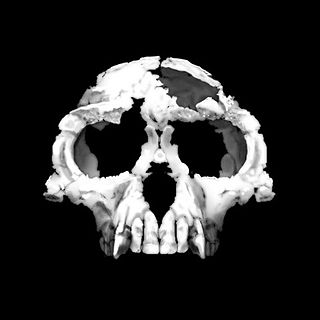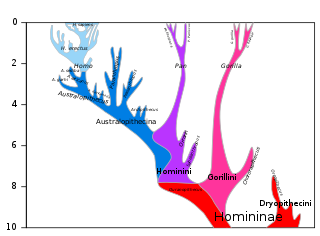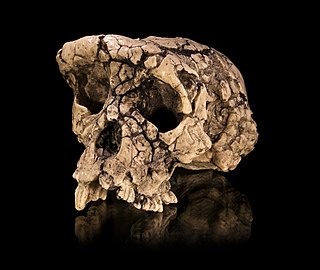 W
WThe Hominini, or hominins, form a taxonomic tribe of the subfamily Homininae ("hominines"). Hominini includes the extant genera Homo (humans) and Pan, but excludes the genus Gorilla (gorillas).
 W
WArdipithecus is a genus of an extinct hominine that lived during the Late Miocene and Early Pliocene epochs in the Afar Depression, Ethiopia. Originally described as one of the earliest ancestors of humans after they diverged from the chimpanzees, the relation of this genus to human ancestors and whether it is a hominin is now a matter of debate. Two fossil species are described in the literature: A. ramidus, which lived about 4.4 million years ago during the early Pliocene, and A. kadabba, dated to approximately 5.6 million years ago. Behavioral analysis showed that Ardipithecus could be very similar to chimpanzees, indicating that the early human ancestors were very chimpanzee-like in behavior.
 W
WArdipithecus ramidus is a species of australopithecine from the Afar region of Early Pliocene Ethiopia 4.4 million years ago (mya). A. ramidus, unlike modern hominids, has adaptations for both walking on two legs (bipedality) and life in the trees (arboreality). However, it would not have been as efficient at bipedality as humans, nor at arboreality as non-human great apes. Its discovery, along with Miocene apes, has reworked academic understanding of the chimpanzee-human last common ancestor from appearing much like modern day chimpanzees, orangutans and gorillas to being a creature without a modern anatomical cognate.
 W
WAustralopithecina or Hominina is a subtribe in the tribe Hominini. The members of the subtribe are generally Australopithecus, and it typically includes the earlier Ardipithecus, Orrorin, Sahelanthropus, and Graecopithecus. All these related species are now sometimes collectively termed australopiths or homininians. They are the extinct, close relatives of humans and, with the extant genus Homo, comprise the human clade. Members of the human clade, i.e. the Hominini after the split from the chimpanzees, are now called Hominina.
 W
WAustralopithecina or Hominina is a subtribe in the tribe Hominini. The members of the subtribe are generally Australopithecus, and it typically includes the earlier Ardipithecus, Orrorin, Sahelanthropus, and Graecopithecus. All these related species are now sometimes collectively termed australopiths or homininians. They are the extinct, close relatives of humans and, with the extant genus Homo, comprise the human clade. Members of the human clade, i.e. the Hominini after the split from the chimpanzees, are now called Hominina.
 W
WThe chimpanzee–human last common ancestor (CHLCA) is the last common ancestor shared by the extant Homo (human) and Pan genera of Hominini. Due to complex hybrid speciation, it is not possible to give a precise estimate on the age of this ancestral population. While "original divergence" between populations may have occurred as early as 13 million years ago (Miocene), hybridization may have been ongoing until as recently as 4 million years ago (Pliocene).
 W
WHomo habilis is a species of archaic human from the Early Pleistocene of East and South Africa about 2.3–1.65 million years ago (mya). Upon species description in 1964, H. habilis was highly contested, with many researchers recommending it be synonymised with Australopithecus africanus, the only other early hominin known at the time, but H. habilis received more recognition as time went on and more relevant discoveries were made. By the 1980s, H. habilis was proposed to have been a human ancestor, directly evolving into Homo erectus which directly led to modern humans. This viewpoint is now debated. Several specimens with insecure species identification were assigned to H. habilis, leading to arguments for splitting, namely into "H. rudolfensis" and "H. gautengensis" of which only the former has received wide support.
 W
WHomo luzonensis, also locally called ubag after a mythical caveman, is an extinct, possibly pygmy, species of archaic human from the Late Pleistocene of Luzon, the Philippines. Their remains, teeth and phalanges, are only known from Callao Cave in the northern part of the island dating to before 50,000 years ago. They were initially identified as belonging to modern humans in 2010, but in 2019, after the discovery of more specimens, they were placed into a new species based on the presence of a wide range of traits similar to modern humans as well as Australopithecus and early Homo.
 W
WHomo rudolfensis is a species of archaic human from the Early Pleistocene of East Africa about 2 million years ago (mya). Because H. rudolfensis coexisted with several other hominins, it is debated what specimens can be confidently assigned to this species beyond the lectotype skull KNM-ER 1470 and other partial skull aspects. No bodily remains are definitively assigned to H. rudolfensis. Consequently, both its generic classification and validity are debated without any wide consensus, with some recommending the species to actually belong to the genus Australopithecus as A. rudolfensis or Kenyanthropus as K. rudolfensis, or that it is synonymous with the contemporaneous and anatomically similar H. habilis.
 W
WKenyanthropus is a 3.5 to 3.2-million-year-old (Pliocene) hominin fossil discovered in Lake Turkana, Kenya in 1999 by Justus Erus, who was part of Meave Leakey's team.
 W
WPředmostí (Skalka), situated in the north western part of Přerov, Moravia near the city of Přerov, is an important Late Pleistocene hill site of Central Europe.
 W
WSahelanthropus tchadensis is an extinct species of the Homininae dated to about 7 million years ago, during the Miocene epoch. The species, and its genus Sahelanthropus, was announced in 2002, based mainly on a partial cranium, nicknamed Toumaï, discovered in northern Chad.